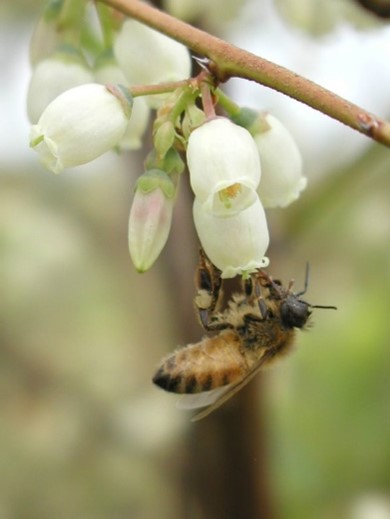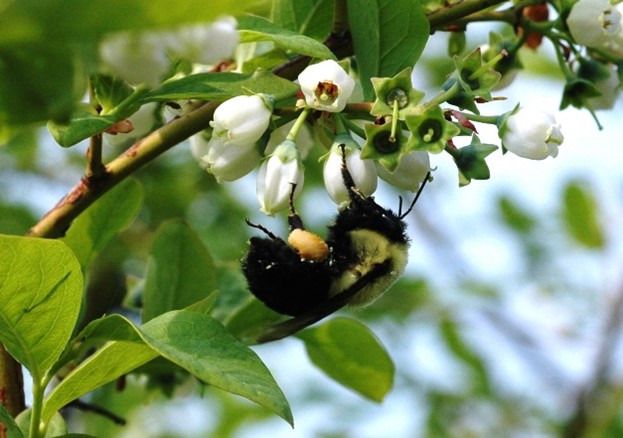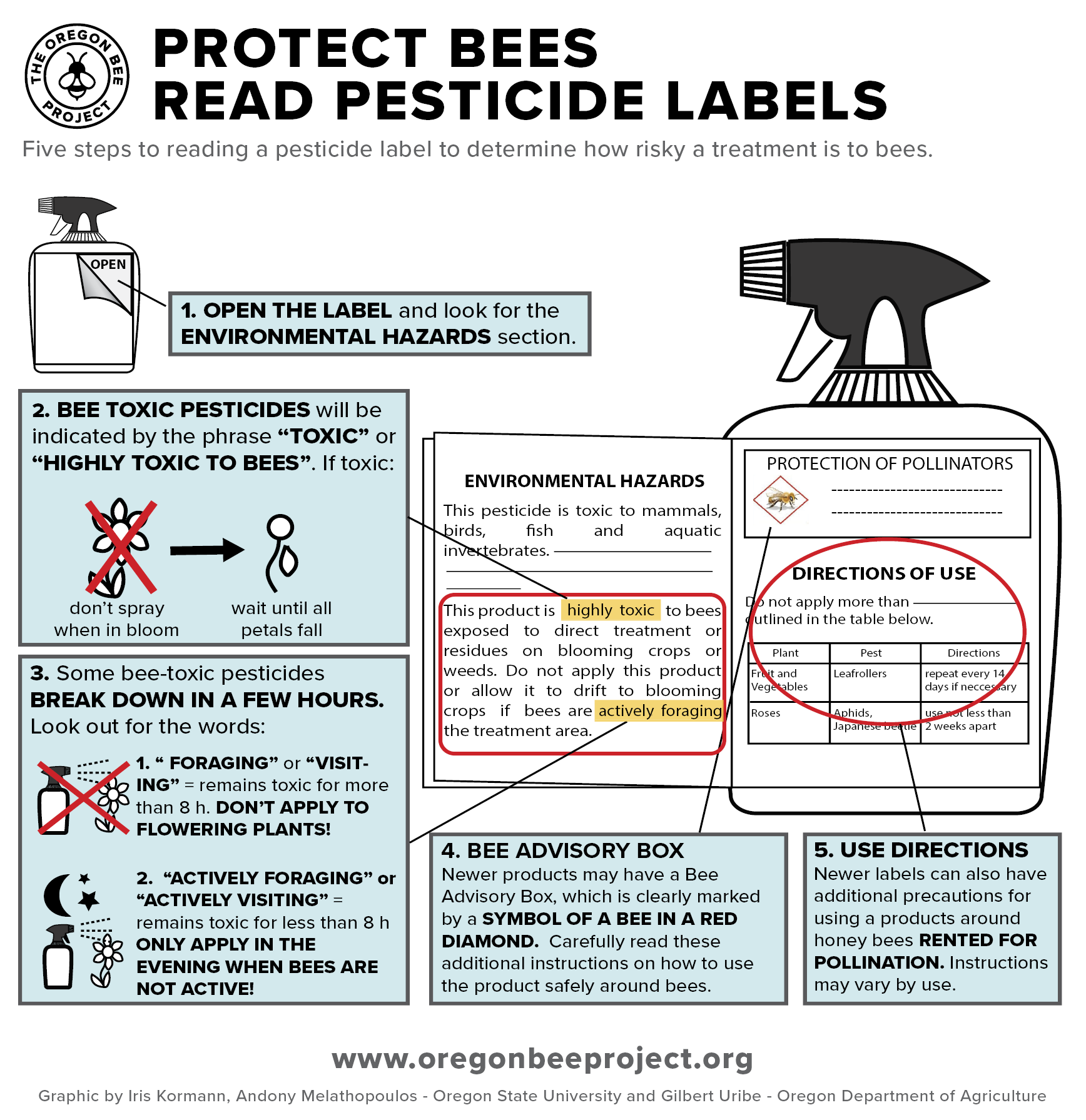
Blueberry Pollinator Stewardship Guide
DOWNLOADJanuary 19, 2021 - Ana Heck & Rufus Isaacs
Last updated: April 10, 2021
Spanish version: Guia del Cuidado de Polinizadores de Arándano
Key recommendations for protecting your investment in pollination
- Use integrated pest management strategies to reduce pesticide exposure to bees
- Minimize the use of insecticides and fungicides during bloom
- Support bee health by establishing bee foraging plantings on your farm
- Learn about bees and share what you know
- Communicate with your beekeeper about bee health and pesticide

Benefits of adopting a pollinator stewardship plan
Bees face many issues that affect their health, including parasites, diseases, lack of forage, and pesticide exposure. Bees often face these challenges at the same time, which can make it difficult for them to thrive. Growers can play a role in supporting pollinator health on their farms. Many growers understand that bees are facing health issues and are willing to help.
This Pollinator Stewardship Guide can help blueberry growers support pollinators on their farms and demonstrate the steps they are taking to help. Growers are in a unique position to help pollinators because of the amount of land they manage and can make a big difference by reducing or mitigating the harmful effects of pesticides on pollinators and increasing flowering plants on their land.
Bees provide pollination to many crops, including blueberries which depend on pollination to produce large berries. Bees collect pollen and nectar from blueberry blossoms and move pollen from flower to flower as they visit. Pollination is a mutually beneficial relationship where bees gather nectar or pollen and the blossoms get pollinated.
Blueberry growers should be aware that blueberry pollination can be hard on honey bees because a bacterial disease that affects developing bees (European foulbrood) is often prevalent among colonies in blueberry pollination. Some beekeepers have stopped pollinating blueberries because they do not think that the amount of money they would earn offsets the cost of unhealthy colonies.
Using this guide, blueberry growers can devise a plan to support bee health and ease the stress bees face while pollinating. Other farming industries that depend on pollination are also making recommendations to support bee health. For example, the Almond Board of California released Honey Bee Best Management Practices for California Almonds, which provides a more comprehensive view of this topic.
Help bees by reducing pesticide exposure
Blueberry growers may consider including the following actions to develop their own farm-specific pollinator stewardship plan:
Scout for pests
Many growers already use scouting as part of their integrated pest management (IPM) strategies. Growers may be able to skip or delay pesticide applications for fruitworms and gall wasps by weekly scouting and considering the risk in each field.
Use pest models
Growers can use degree day models through Michigan State University Enviorweather. Models exist for fruitworm pests and gall wasps. These models can help growers optimize application timing and potentially reduce the need for a follow-up spray.
Select pest-resistant varieties of blueberries
Growers can also consider selecting varieties of blueberries that are resistant to insect and disease pests, or that ripen early to avoid some pests. For example, Jersey and Liberty varieties of blueberries are more susceptible to gall wasp, so avoiding those cultivars can indirectly reduce pesticide risk to bees.
Avoid tank mixing
There are clear economic benefits to mixing pesticides in the tank, but the effects of tank mixes on bees are unpredictable and potentially harmful. Some combinations are much more toxic to bees when applied together than when applied individually. While reducing tank mixes can be costly and require more time, blueberry growers should try to reduce tank mixes, especially during bloom, to avoid negative effects on bees.
Some mixes of insecticides and fungicides have been identified as being more toxic to bees, but the effects of many tank mixes and pesticide combinations on bees have not been tested.
Examples of known mixtures of insecticides and fungicides that increase mortality to bees[i],[ii]:
|
Insecticides |
|
Fungicides |
|
Neonicotinoid insecticides: acetamiprid,* imidacloprid* |
More toxic when mixed with |
epoxiconazole, propiconazole, triadimefon, triflumizole, uniconazole-P |
|
chlorantraniliprole* |
More toxic when mixed with |
propiconazole, iprodione |
*not allowed for use during bloom
Avoid using adjuvants and surfactants
Some adjuvants and surfactants make pesticides more toxic to bees because they make it easier for pesticides to penetrate a bee’s outer cuticle. However, the effects of most adjuvants and surfactants on bees have not been studied. It is suggested that the use of adjuvants and surfactants be limited to instances where they are recommended on a pesticide’s label.
Spray when bees aren’t flying (at night or during cool weather)
To avoid direct pesticide exposure to bees, growers should avoid applying pesticides when bees are flying. Honey bees typically do not fly much after sunset or when temperatures are below 50°F, but bumble bees and other native bees can fly when it’s cooler.

Spray when wind speed is low
Pesticides applied at windy times will drift from the target crop to flowering weeds and ditches where bees are foraging or nesting. Growers can reduce direct pesticide exposure to bees by spraying only when wind speeds are low. Most blueberry growers already spray pesticides in the early morning or late evening to avoid drift.
Mow flowering weeds that may be exposed to pesticide drift
Many weeds, such as dandelions and clover, are very attractive to bees. Although flowering weeds may provide additional forage for bees, they can become a hazard if pesticides drift onto them. Prior to pesticide application, blueberry growers should consider mowing flowering weeds in their rows and field margins if the weeds risk being exposed to pesticides.
Apply pesticides with accuracy and precision
Always follow a pesticide’s label instructions. Information related to bees may appear in the sections on pollinators, environmental hazards, and/or directions of use. Growers should also make sure that their sprayers are calibrated so that the pesticide is applied correctly. Most growers calibrate their machines since there is a cost incentive to targeted applications and because calibration records are important for audits.

Which pesticides are safe for bees?
Many growers are concerned about pollinator health and ask which pesticides are safe for bees. While growers are required by law to not spray the most toxic insecticides when bees are foraging, even those considered “more safe” can have negative effects on bee growth, development, behavior, and nutrition that can hurt honey bee colony survival or size. These sublethal effects can reduce their pollination strength and limit the beekeeper’s business.
We know which pesticides are highly toxic to adult honey bees, and their use is restricted during bloom. However, for most pesticides we don’t know enough about their effects to claim that they are “safe”S for bees. Many pesticides are only tested on adult honey bees. These tests do not tell us how developing honey bee brood or other bee species, such as bumble bees, may be affected by the pesticide. Some pesticides that do not kill adult honey bees in the field may be toxic to developing honey bee larvae and pupae or to other bee species. For example, insect growth regulators can harm and kill developing bees.
Pesticides that aren’t highly toxic to adult honey bees may still be harmful. Most pesticides aren’t evaluated for sublethal effects, which may lead to reduced lifespan or a lower immune response making it harder for bees to recover from infection. Sublethal effects on individual honey bees can cause ripple effects through the hive, leading to colony decline and eventual colony death.
Since most effects of pesticides are unknown, growers should be cautious when applying pesticides, and should follow the pesticide label for every application.
Bee Precaution Pesticide Ratings
Bee precaution ratings from University of California Agriculture & Natural Resources Statewide Integrated Pest Management Bee Program present up-to-date information about the effects of specific pesticides on bees. The site ranks pesticides based on studies on each of the pesticides. It should be noted that some pesticides have been studied more than others and that some effects may be unknown.
Insecticides
The insecticides that are registered for use during blueberry bloom have a range of risk to bees. The B.t. formulations have no direct toxicity to bees at applied rates. Grandevo does not have a bee safety warning on the label, whereas the label for Venerate states that it should not be applied while bees are foraging. The other insecticides registered for use during blueberry bloom are all insect growth regulators, and it is also advised that application of these insecticides are made late in the day or early morning when bees are not actively foraging to reduce exposure. This application timing would reduce the levels of residue being returned to hives, where the insecticide residues have the potential to disrupt development of bee larvae over the coming weeks. Waiting to apply insecticides until after hives are removed from the fields can also greatly reduce insecticide impacts on honey bee colonies.
Insecticide and relative risk to bees, ranked from less risk (#1) to more risk (#5) [iv] [iii]
- DiPel*, Javelin (B.t.)*
- Grandevo*, Venerate*
- Confirm**
- Intrepid**
- Esteem**, Rimon**
**insect growth regulators, which may harm developing bees *organic insecticides
Fungicides
Since fungicides target fungus, it can seem counterintuitive that they would affect bee health. Nevertheless, fungicides can be quite harmful to bees. Many pesticides bind to pollen, which is important to the development of young honey bee larvae and for the nutrition of young worker bees. Fungicides have been shown to cause decreased larval survival and abnormal development in honey bees, which can lead to decreased colony population. They can also have detrimental effects on honey bee memory, learning, and behavior. Effects of sublethal pesticide exposure can be difficult to detect since it can be weeks or months before a change to colony size is noticeable.
Fungicides in the Fungicide Resistance Action Committee (FRAC 3) group are known to increase toxicity to bees. This group includes Indar, Proline, Quash, Quilt Xcel, and Tilt.
Communication with your beekeeper
Expectations and contracts with your beekeeper
Many agreements between growers and beekeepers are made without contracts, but growers may consider using a contract to set clear expectations and improve communication. Examples of sample contracts can be found online from MSU Michigan Pollinator Initiative.
Growers interested in inspecting colonies should talk to the beekeeper when they form a contract or arrangement. Beekeepers can open hives so the grower can see colony strength, and strength is measured in frames covered with bees. Inspections should be conducted soon after the hives are delivered for pollination. When colonies are inspected toward the end of their time in pollination, it is difficult to tell whether weak colonies were weak to begin with or if they became weak during their time in pollination.
Protecting beekeepers from pesticide exposure
Growers should also be concerned that beekeepers may be exposed to pesticides. Beekeepers may not have received training related to pesticide exposure. If you are planning on applying a pesticide during the window of time when beekeepers might visit their colonies, please inform your beekeepers, and let them know when the re-entry interval will expire.
Placement of hives
Honey bees fly 2 miles or more for food, and a colony’s range can span 8,000 acres. It is not necessary to place honey bee hives in the middle of blueberry fields to get pollination. Hives placed on the outsides of fields or behind buffers of wooded areas will have less direct exposure to pesticides, which may be beneficial to maintaining the strength of the honey bees and to the health of the beekeepers. It is also beneficial to consider locations that are not susceptible to becoming muddy. Muddy areas force the beekeeper to delay moving hives after pollination, which can in turn lead to a delay in certain insecticide applications.
Understanding honey bee biology and the risks of pesticides
It’s helpful for growers to understand honey bee biology in order to protect their investment in pollination services. A colony is a superorganism, meaning that beekeepers consider all the bees living in a hive to be an organism instead of thinking about bees on the individual level. The queen bee lays eggs that develop into queens, drones, or workers. Queens are typically raised if a colony is preparing to swarm, the colony is replacing their current queen, or if the colony is suddenly queenless. There is usually just one queen in a colony. Most of the bees in the colony are worker bees (non-fertile females). The worker bees take on different roles as they age. Younger workers clean cells, feed the queen, draw wax comb, and feed developing bee larvae, while older worker bees forage for pollen, nectar, tree resins, and water to bring back to the hive. Younger bees and developing brood depend on the nectar and pollen that the foraging bees bring back to the hive. Male bees, or drones, try to mate with young queens from other colonies. They make up about 5-20% of the colony in the spring through fall, and the workers kick the drones out before winter.
Honey bees, bumble bees, and pollination
When crops need pollination, growers need strong colonies with many older, foraging bees. When foraging bees die outside of the hive (due to pesticide exposure or another cause), younger worker bees will take on foraging at a younger age. This transition causes stress on the colony and shortened lifespans. Similarly, when brood or young bees die unexpectedly, older bees may revert to conducting in-hive tasks instead of foraging. So, preventing bee loss protects the function of the colony.
Other ways to help bees
Plant for bees
One of the best ways to help bees is to plant flowering trees, shrubs, and wildflowers. Good nutrition from a wide range of flowers throughout the growing season can help bees better deal with pesticide exposure, parasites, and diseases. As people who own or manage large areas of land, growers are in a unique position to provide large areas of quality habitat for bees. Creating and maintaining areas of natural habitat takes work, but it may also attract wild bee species and other beneficial insects to your farm. Growers can find resources about installing pollinator habitat from MSU’s Pollinator Initiative.
Learn about pollinators and spread the word
Growers can help pollinators by learning more about them and spreading the word. One educational opportunity is Michigan State University’s free, online Pollinator Champions course. The course takes about 5-10 hours to complete, and it can be done at your own pace. The course covers pollination basics, pollinator diversity, pollinator health issues, and how to support and protect pollinators. After completing the free course, you may choose to pay $30 for a certificate and outreach materials. You might also consider encouraging school-aged children to learn about bees and how they relate to the natural environment.
Some blueberry growers have suggested that it is important to talk with neighboring growers about managed bees and pesticide exposure. Honey bees forage 2 miles or more for food, and they may come into contact with pesticides that other applied by other growers. Some blueberry growers let neighboring growers know when managed bees are in the area for pollination to discourage pesticide applications that may harm bees.
Summary
Bees face many threats to their health including diseases, pests, lack of good forage, and exposure to pesticides. Blueberry growers depend on bees for pollination and already take steps to try to improve bee health. Growers have many opportunities to help bees by creating a pollinator stewardship plan for their farm, and this document provides guidance in the important steps to take to benefit bees, beekeepers, and blueberry production.
Process for forming this document
This Blueberry Pollinator Stewardship Guide was authored by Ana Heck from the Michigan State University Pollinator Initiative with input and consultation from growers, Extension Educators, and researchers. The guide is an outcome of the Michigan Managed Pollinator Protection Plan.
Please email Ana Heck at heckanar@msu.edu to provide suggestions or feedback for this guide.
Funding
The Michigan Department of Agriculture and Rural Development secured partial funding for an employee at MSU’s Michigan Pollinator Initiative to take the lead on ensuring that we are working on action items in Michigan’s Managed Pollinator Protection Plan.
Acknowledgments
Thank you to the Michigan Blueberry Commission and to the following individuals who contributed to this guide: Scott Barnes, Carlos Garcia-Salazar, Nick Groenhof, Rolland Groenink, Dennis Hartmann, Shelly Hartmann, Rufus Isaacs, Mark Longstroth, Meghan Milbrath, Timothy Miles, Jacquelyn Perkins, Gabriela Quinlan, Adam Shinske, Dave Trinka, and Jenna Walters. All photos by Rufus Isaacs.
References
[i] Wade, A., Lin, C., Kurku, C., Regan, E. “Combined Toxicity of Insecticides and Fungicides Applied to California Almond Orchards to Honey Bee Larvae and Adults.” Insects, vol. 10, no. 1, 8 Jan. 2019, p. 20., doi:10.3390/insects10010020.
[ii] Glavlin and Bozik 2013 in Albert, J. & Milbrath, M. (2018). Fungicides during bloom – the pollination paradox: Practices that maximize productivity can undermine the pollination process, reducing profitability.
[iii] A list of insecticides used during blueberry bloom can be found in the Michigan Fruit Management Guide 2020 (E0154) from Michigan State University Extension: https://www.canr.msu.edu/resources/fruit_management_guide_e0154
[iv] Rankings developed in consultation with Dr. Rufus Isaacs, Small Fruit Entomologist at Michigan State University



 Print
Print Email
Email
